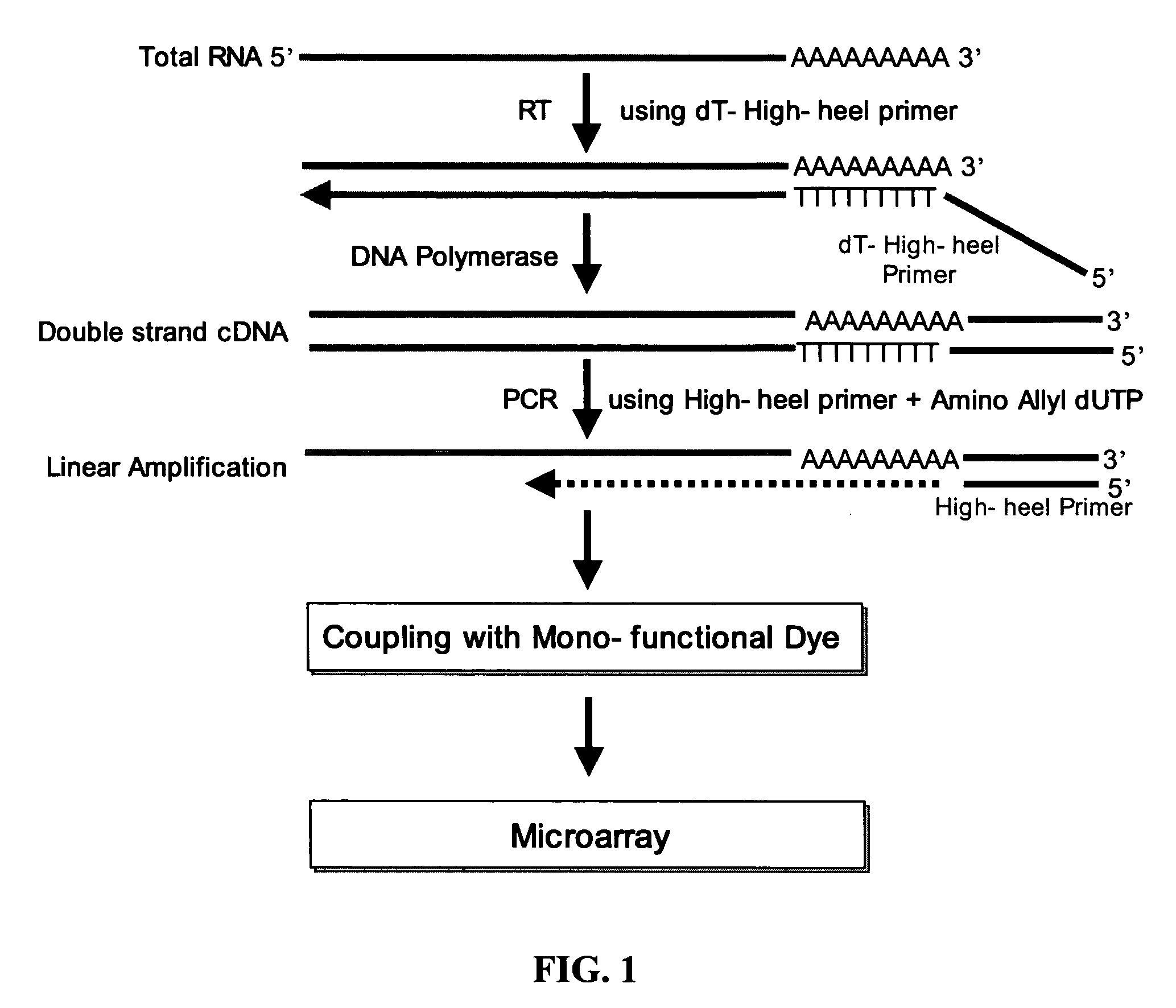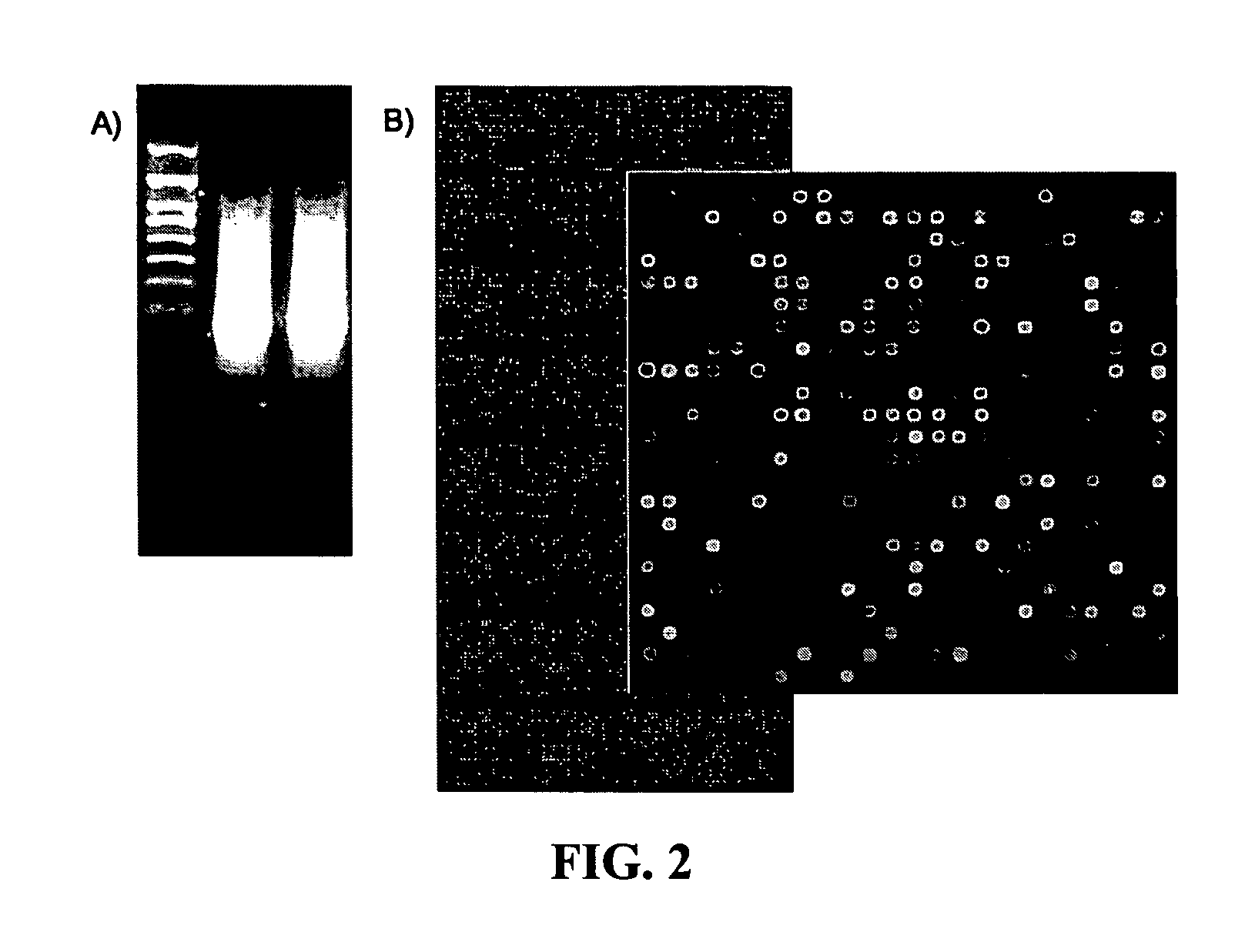Method for linear amplification of RNA using high-heel primer
- Summary
- Abstract
- Description
- Claims
- Application Information
AI Technical Summary
Benefits of technology
Problems solved by technology
Method used
Image
Examples
example 1
Synthesis of cDNA by Reverse Transcription Reaction
[0038] 2 μg of a poly dT-high heel primer of SEQ ID NO: 2, obtained by binding poly dT to the 3′-terminal end of a high heel primer represented by SEQ ID NO: 1, was mixed with less than 1 μg of total RNA, and the mixture was allowed to react at 65° C. for 10 minutes so as to anneal the poly dT-high heel primer in the total RNA. Then, the annealed RNA was added with enzyme reactant including transcriptase (400 unit, Finzyme, Finland), dNTP mixture (10 mM, Solgent, Korea), RNAsin (5 unit, Promega, USA), and the like, and subjected to reverse transcription reaction at 42° C. for 2 hours, so as to synthesize cDNA. In this step, an RNA / cDNA hybrid is formed.
[0039] The primer of SEQ ID NO: 2 is the poly dT-high heel primer used in this Example. In this primer, V is one base selected from the group consisting of A, G and C, and N is one base selected from the group consisting of A, T, G and C.
5′-CGC TGG GCC GAC CGG GCG CGGSEQ ID NO: 1G...
example 2
Synthesis of Double-Stranded cDNA
[0040] To the RNA / cDNA hybrid synthesized in Example 1, enzyme reactant including RNase H (2 unit, Invitrogen, USA), DNA polymerase (40 unit, Invitrogen, USA), DNA ligase (6 unit, Invitrogen, USA), dNTP mixture (10 mM, Invitrogen, USA) and the like, was added, and the mixture was allowed to react at 16° C. for 2 hours, so as to synthesize a double-stranded cDNA. Then, the synthesized cDNA was treated with 7.5 μl of 1M NaOH / 2 mM EDTA at 65° C. for 10 minutes.
[0041] In order to extract only synthesized double-stranded cDNA, 100 μl of a solution of the synthesized sample in nuclease-free water was mixed with 200 μl of PCI (25:24:1, Sigma, USA) in a phase-lock gel tube (Eppendorf, Germany), and the mixture was centrifuged at 13,000 rpm for 5 minutes. The aqueous phase was transferred into a fresh tube, and precipitated at −70° C. for 5 minutes by the addition of 0.5 parts of 7.5M ammonium acetate, 1 μl of linear acrylamide and 2.5 parts of EtOH, follow...
example 3
[0042] The double stranded cDNA extracted in Example 2 was added with 2 μg of a high-heel primer of SEQ ID NO: 1 (Bioneer, Korea) and enzyme reactant including Taq polymerase (5 unit, Solgent, Korea), dNTP (10 mM dATP, 10 mM dCTP, 10 mM dGTP, 2 mM dTTP, and 8 mM aminoallyl-dUTP) and the like and subjected to linear PCR amplification. The PCR amplification consisted of denaturation at 94° C. for 10 minutes, followed by 35 cycles of 45 seconds at 94° C. and 2 minutes at 72° C., and then extension at 72° C. for 5 minutes. The linear PCR amplification product was isolated and purified with a PCR purification kit (Intron, Inc., Korea).
[0043] As defined herein, the high heel primer used above is a primer which is designed to be annealed at a temperature of 65-75° C. and preferably 72° C. Also, it can optimize a linear amplification process since the efficiency of Taq polymerase is maximized at 72° C. Also, it can eliminate the risk of exponential amplification since ...
PUM
| Property | Measurement | Unit |
|---|---|---|
| Temperature | aaaaa | aaaaa |
| Temperature | aaaaa | aaaaa |
| Mass | aaaaa | aaaaa |
Abstract
Description
Claims
Application Information
 Login to View More
Login to View More - R&D
- Intellectual Property
- Life Sciences
- Materials
- Tech Scout
- Unparalleled Data Quality
- Higher Quality Content
- 60% Fewer Hallucinations
Browse by: Latest US Patents, China's latest patents, Technical Efficacy Thesaurus, Application Domain, Technology Topic, Popular Technical Reports.
© 2025 PatSnap. All rights reserved.Legal|Privacy policy|Modern Slavery Act Transparency Statement|Sitemap|About US| Contact US: help@patsnap.com



